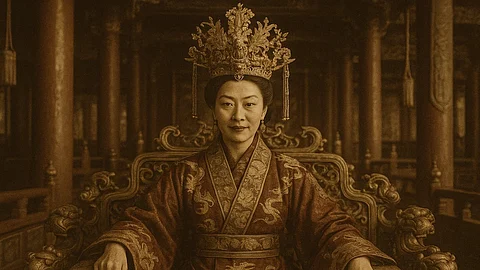From A Mere Concubine to Becoming China’s Sole Female Emperor During The Tang Dynasty. Who Was Wu Zetian?
Key Points:
Wu Zetian was the first and only woman to rule China as emperor, breaking traditional gender roles in a male-dominated society.
Starting as a concubine, she skilfully navigated court politics, eliminated rivals, and eventually declared herself emperor in 690 AD.
Wu Zetian reformed the imperial examination system by opening it to commoners.
During China’s dynastic rule spanning over 2,000 years, many emperors came and were dethroned. The period from 220 BCE to 1912 saw a total of 557 emperors. According to Chinese political history, these emperors were considered the “Sons of Heaven” who had a divine connection between heaven and earth. In medieval China, Confucianism was widely practiced and it emphasized on moral character and social duties.
This belief system often undermined the value of women and is associated with their suppression. At a time when women were only expected to stay at home, cook, and have children, there was one woman who dared to break these stereotypes. She later became the only female emperor in the history of China.
Her name was Wu Zetian. Who was she? Let's find out!
Who Was Wu Zetian?
Wu Zetian was born on 17 February 624 AD to a timber merchant. Although she was not of noble birth, her family was wealthy enough for her to receive an education, which was uncommon at the time. At the age of 14, she was selected to become a concubine at the royal court under the rule of Emperor Taizong. She used her education and skills to advance her position from a concubine to becoming Taizong’s secretary.
After Taizong’s death, his son Gaozong became the third emperor of the Tang dynasty. Wu Zetian formed a relationship with him to avoid being exiled after Emperor Taizong’s death. It was customary at the time that if an emperor’s concubine had not given birth to a child before his death, she must spend the rest of her life in a religious institution.
Zetian formed a relationship with the former emperor’s son Gaozong in order to get out of the banishment to the religious institution.
Wu Zetian’s Rise to Power
Wu’s rise from a mere fifth-tier concubine to the first female emperor of China was the result of a strategically laid-out plan, not just luck or coincidence. Determined to reach the top, she quickly advanced through the ranks of concubines and bore Gaozong's child.
Wu executed a plan to remove Gaozong’s wife, Empress Wang, from power. She accused Wang for smothering her newborn infant. Furious, Emperor Gaozong imprisoned Wang and eventually locked her away. In 655 AD, Wu Zetian officially became the empress and bore Emperor Gaozong’s children—four sons and one daughter. She even had the former empress and her associate Xiao executed under the pretext that Wang posed a potential threat to her.
And that is how Wu Zetian made sure she had no competition.
Zetian began to get more involved in state affairs as Emperor Gaozong’s health declined. Gaozong died in 683 AD at the age of 55, and the power to rule the empire fell completely into Wu Zetian's hands. Following his death, she became the Dowager Empress—a title given to the mother or widow of an emperor after his demise.
See Also:
Wu Zetian did not retire as tradition dictated. Instead, she maintained her position in the court and continued to rule as regent for her son, Emperor Ruizong. Soon, she went even further by forcing Ruizong to resign from the throne. In 690 AD, Wu Zetian crowned herself as the Empress of China and renamed the Tang dynasty to the Zhou dynasty. During her reign, Wu Zetian was known for her effective governance, she used ruthless and cruel methods to eliminate any potential rivals who threatened her authority and position.
From concubine consort to dowager empress to officially becoming the Empress of China, Wu Zetian ruled the empire for 15 years before her death on 16 December 705 AD at the age of 81. During her reign, she introduced numerous measures to expand the empire’s reach under her strong leadership.
One of Empress Wu Zetian’s most prominent reforms was in the imperial examination system, which was a civil service exam in imperial China. This exam was conducted to select candidates for the state bureaucracy. Wu Zetian changed the previous system, which favoured candidates based on their titles and family connections. Under her reign, the imperial examination allowed commoners from all social classes to participate, and selections were based on individual competency and ability rather than social status or connections.
Wu Zetian was eventually removed from power after a coup orchestrated by officials determined to overthrow her and restore the Tang dynasty. This coup, known as the Shenlong Coup, resulted in Wu Zetian’s abdication and her son Zhongzong ascending to the throne as the next emperor of China (705–710 AD). Wu Zetian died a few months later but is still remembered as a fearless, ruthless, and determined ruler.
For 15 years, she reigned as the Holy and Divine Emperor of the second Zhou dynasty. She was the first and only female emperor in Chinese history. She was Wu Zetian. [Rh/VS]
Also Read:


